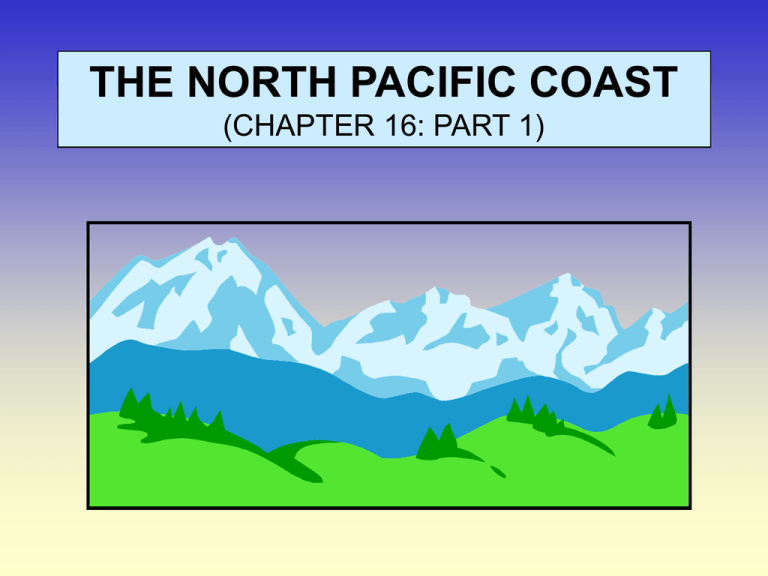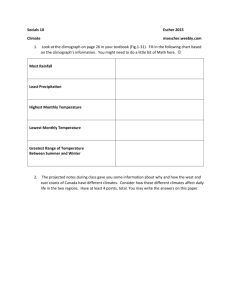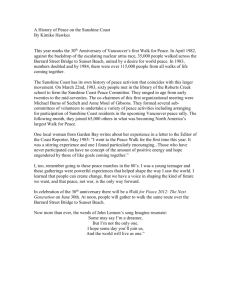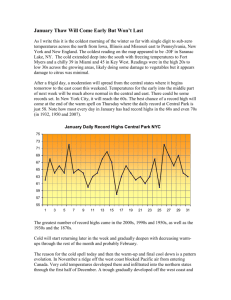THE NORTH PACIFIC COAST I
advertisement

THE NORTH PACIFIC COAST (CHAPTER 16: PART 1) INTRODUCTION • The North Pacific Coast has also been labeled as "Ecotopia." • Strongly subjected to a Maritime influence and dominated by rugged terrain • Relatively isolated from the rest of North America, much to the satisfaction of its inhabitants • The region is mapped on page 367. NORTH PACIFIC COAST PHYSICAL GEOGRAPHY • CLIMATE The region of heaviest annual precipitation amounts on the continent Average precipitation >75 inches/year is common. 150 inches/year is the norm on the western side of the coastal ranges. Parts of Vancouver Island receives about 230 inches/ year Winter precipitation exceeds summer amounts throughout the region. PRECIPITATION PATTERNS PHYSICAL GEOGRAPHY CLIMATE (continued) Abundant rainfall supports tremendous tree growth in areas such as the Olympic Peninsula. Orographic Rainfall (precipitation that results when moist air is lifted over a topographic barrier) is the dominant source of precipitation in the region. PHYSICAL GEOGRAPHY • TOPOGRAPHY The Coast Ranges-Oregon and Washington Reach elevations of 4,000 feet Responsible for the rain shadow effect (see map on page 368). Further inland are the rugged Cascades Extend north into British Columbia Merge with the Insular Mountains, and are known as the Coast Mountains PHYSIOGRAPHIC PROVINCES PHYSICAL GEOGRAPHY TOPOGRAPHY (continued) Mt. McKinley is located at the region's northern extremity 20,320 feet in elevation- the highest point in North America The mountain's vertical rise (in excess of 18,000 feet) is the highest in the world. The St. Elias Mountains in Canada are the world's highest coastal mountains Mt. Logan reaches a height of 19,700 feet. SETTLEMENT PATTERNS • AMERICAN INDIANS Pre-European population of the area - relatively large Based on a simple hunting and gathering economy Depended largely on deer and salmon, and supplemented by berries, roots, and shellfish Large concentrations of Indians were found along the coast, particularly in coastal valleys. Some tribes constructed large dugout canoes of cedar and became notable seafarers. The Puyallups are one of the few remaining tribes Fairly well known because of recent legislation granting them “salmon rights” SETTLEMENT PATTERNS • EUROPEANS Russians were the first Europeans to establish settlements along the coast. Initially established settlements during the late 1700s Consisted mainly of fur-trading posts ranging from Southeast Alaska to Northern California. U.S./Canadian boundary @ 49 North -1846 Alaska was purchased from Russia in 1867 for the paltry sum of 7.2 million dollars. Oregon's population - strong New England heritage Washington - large number of people with Scandinavian roots SETTLEMENT PATTERNS • MAJOR CITIES TODAY VANCOUVER Canada's third largest city More than 1.2 million people Planners expect the city to double is size within 30 years. Vancouver serves as the western outlet for Interior Canada. Canada's busiest port, focused on wood products and wheat that is destined for Asian markets. VANCOUVER SETTLEMENT PATTERNS MAJOR CITIES TODAY (continued) SEATTLE Largest city of the North Pacific Coast - late 1800s Founded as a logging center. Since WWI, it has been the home of Boeing Aircraft Sometimes referred to as the world's largest "company town," as Boeing had 103,000 employees during the 1960's. Employment at Boeing subsequently fell to about 50,000 by the early 70s Rebounded in the 1980s, providing more than 106,000 jobs by the end of the decade. Today, a middle-class city, appealing by any survey. SEATTLE SETTLEMENT PATTERNS MAJOR CITIES TODAY (continued) PORTLAND Serves as the agricultural focus and shipment point for western grain. Food processing and the manufacturing of wood products are key industries to the city. Boasts a more diversified economy than Seattle’s. REGIONAL ECONOMY • FORESTRY British Columbia produces 45% of Canada's timber. Washington, Oregon, and California account for more than 50% of the U.S. total. Douglas Fir is the species that is currently of prime importance. Although the region's first major industry, forestry was not nationally important until the early 1900s. Current cutting techniques include "selective cutting," "shelterwood cutting," and "clear cutting". Japan has been a major market for North America timber, especially from Alaska and British Columbia. REGIONAL ECONOMY • FORESTRY (continued) • Controversy surrounds the use of "clear cutting" and the harvesting of Northern California redwoods, the world's tallest (and among the oldest) trees. A target for preservationists, the Redwood National Park was established in the late 1960s. POWER AND DAMS The plentiful precipitation and rugged topography of the area provides hydroelectric potential unmatched anywhere in North America. The rivers of Oregon and Washington account for over 40% of the U.S.'s hydroelectric potential. REGIONAL ECONOMY POWER AND DAMS Columbia River has the greatest power generating potential in the region A flow volume greater than the Mississippi River A drop of nearly 1,000 feet during the course of its 750 mi route from U.S./Canadian border to the sea. Grand Coulee - the region's largest dam Completed in 1933, and ten more dams have since been constructed downstream. Recent addition of new generators at Grand Coulee Dam have tripled its capacity The world's largest single power producer. REGIONAL ECONOMY POWER AND DAMS Cheap power has succeeded in attracting a number of heavy power-using industries to the region, similar to scenarios with the TVA or Niagara River Project. No dams are permitted in Hell's Canyon World's deepest gorge, cut by the Snake River between Oregon and Idaho This section of the Snake was classified as a "Wild and Scenic River" in 1975. AGRICULTURE • • Most of the region's crops are grown for local markets. Impacts of transferability & intervening opportunity Producing areas and products Willamett River Valley- forage crops, dairy products, and strawberries Puget Sound Lowlands (Washington)- dairy products and peas Yakima and Wenatchee Valley- apples via irrigation from the streams and rivers of the Cascades "Hilly Country" (east-central Washington)- wheat via dry farming THE NORTH PACIFIC COAST (CHAPTER 16: PART 1)







